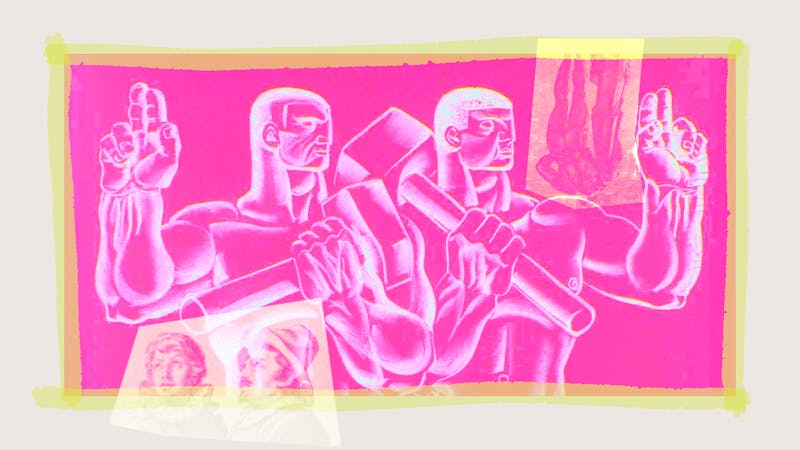Venturing through the Philadelphia Museum of Art (or any art museum really), you’re guaranteed to see a hypersexualized, “ideal” version of the female anatomy: ample bosoms, round bottoms, and long flowing hair. Male physiques at the museum are seldom presented with the same objectification for voyeuristic purposes.
But Macho Men: Hypermasculinity in Dutch & American Prints is unlike other exhibitions, showing aggressive men teeming with testosterone. In the exhibition, late–16th–century Dutch renditions of “manhood and citizenship” coexist alongside American Great Depression representations of the working class. Featuring inhuman proportions of rippling abs, chiseled muscles, thick veins, Macho Men verges on the grotesque. Its three galleries contemplate overly muscular men against the museum’s backdrop of passive femininity.
The first works showcased are Philadelphia artist James A. Rose’s Null and Void. Rose’s striking graphite drawings of his face explore “issues surrounding spirituality, race, and sexuality,” through the lens of his experiences as a gay Black man. Rose says he is both “seen and not seen usually for all the wrong reasons.” This perspective runs through the rest of Macho Men. Modern audiences can now view these paintings of brawny white men—made by white male artists—with a 21st–century understanding of sexuality and constructs of gender and race.
In the fight for independence of the Dutch Republic from the Spanish monarchy, burly men symbolized the nationalistic efforts of Dutch civilians. Hendrick Goltzius’ 1589 depiction of The Great Hercules presents the Greek mythological hero reimagined to personify the Dutch struggles against tyranny. With a Dutchman’s mustache and thick muscles, Hercules symbolizes the seven united provinces of the Dutch Republic joining together. Jan Harmensz. Muller’s engravings Fortune Distributing Her Gifts from 1590 depicts nearly a hundred nude muscular men entwined in fight for Fortune personified. Many are portrayed as though posing and flexing their bulbous muscles.
Centuries later, Depression–era lithographs of muscular men performing industrial labor highlighted the productivity of the proletariat. In Arthur Murphy’s 1936 Steel Riggers No. 2 – Bay Bridge lithograph depicts the violence that broke out between striking dockhands and strikebreakers in San Francisco, with one caveat. The three workers are nude, with just helmets for protection. They pull on a rope, flaunting their muscles. Rockwell Kent’s 1941 Lowering a Pipe Section through a Building Platform similarly uses a self explanatory title, for an advertising campaign promoting the United States Pipe and Foundry Company. But the focus is the muscular men, which prompts the audience to examine the male subjects in relation to each other rather than the pipe itself.
Richard Correll’s depiction of the American folk hero in Packing Lumber was published by the Works Progress Administration in the 1937–38 Paul Bunyan series. The broad–shouldered lumberjack takes up the entire frame as he looks up with determination, carrying a large piece of wood that demands adoration for the feat. Juxtaposed with Dutch artist Jan Harmensz. Muller’s The Fight between Odysseus and Irus from 1589, both paintings illustrate superhuman figures whom ordinary men should idolize. The Greek king of Ithaca is shown returning from the Trojan War, destroying an enemy without hesitation. Another of Muller’s works includes Cain Killing Abel from 1589. The Biblical characters are seen in combat in the first murder—but both are nude and muscular.
In line with the mythic heroes, an overwhelming amount of the work in the exhibition features Greek mythological figures. Dutch artist Hendrick Goltzius’ The Farnese Hercules from 1592 renders the backside of the well–known divine protector, as two ordinary mortals stare up at him. Because Hercules is nude and facing away, attention is directed towards his back muscles, buttocks, and enormous thighs and calves. The two male spectators are fully clothed, and their faces are in awe. Similarly, Goltzius’ engravings The Four Disgracers shows Icarus, Phaeton, Tantalus, and Ixion all “falling from grace” due to their various shortcomings. Their positions draw focus to their muscular thighs, butts, and arms, rather than their obscured faces.
A standout piece of the collection is The Sculptor by American artist Michael Gallagher. The 1937 wood engraving depicts another WPA artist, Yoshimatsu Onaga, working on his own sculpture. The hypermasculine version of Onaga is similar to the gargantuan, bulky sculpture he is hammering, titled N.R.A., after the National Recovery Administration, which advocated for workers’ rights. Historically apt, Onaga lost his WPA employment for being a Japanese citizen. Another one is Primary Accumulation, by Hugo Gellert, which depicts nude men with hammers next to the The Communist Manifesto, hoping to empower the proletariat against the exploitation of capitalism. Gellert, the founding editor of the socialist magazine The New Masses used art to mobilize the working class.
Many of these paintings beg to be seen through a homoerotic lens. American artist Paul Cadmus’ The Fleet’s In depicts servicemen having a boisterous time together. Cadmus, who was gay, often included subtle queer interactions between the men in his etchings, such as a man offering a sailor a cigarette. His subjects are typically turned away from the audience, drawing focus to the butts and bulges of the sailors. The Last Fall by American Richard Correll shows two wrestlers in an almost romantic embrace, which would be indisputable if not for the telltale wrestling ring’s ropes behind them.
The depictions of superhuman versions of masculinity served various purposes, whether as pure propaganda or to provide a sense of national unity. Throughout history, the ideal version of manhood is one with rippling muscles—used for labor, combat, or civic duty. Apparently, it’s the perseverance of man that gave strength to the masses during times such as Spanish imperialism and the Great Depression.
However, upon closer examination, these works show the faults of touting this image as the masculine ideal. Exploring Macho Men with an understanding of hidden homoeroticism throughout history can help dismantle the constructs around masculinity being about brute strength and aggression.












